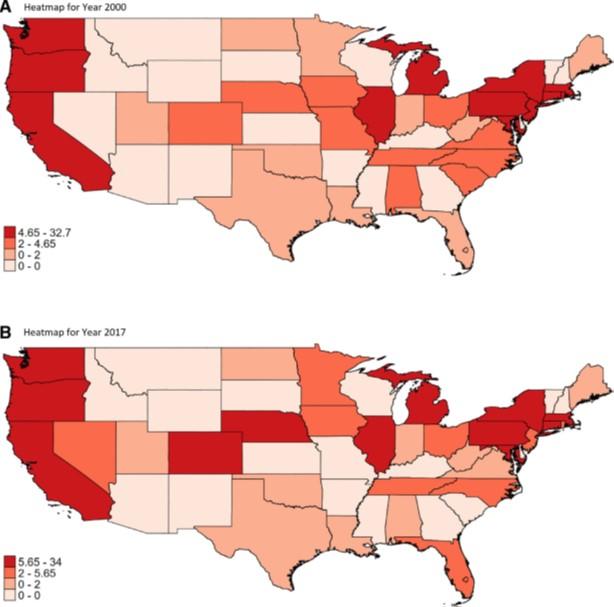Ann Arbor, September 14, 2020 – New research from the University of Alabama at Birmingham (UAB) shows that gun laws in neighboring states have an effect on gun death rates in adjoining states. In findings published in the American Journal of Preventive Medicine, published by Elsevier, weaker firearm laws in neighboring states correlated with more firearm deaths within a state. This is useful information for state policymakers who sometimes have to justify and defend the need for firearm laws in their state.
“Although stronger state gun policies were associated with decreased firearm deaths, the presence of permissive neighboring states undermined this protective effect,” said lead investigator Bisakha Sen, PhD, Blue Cross Blue Shield Endowed Chair in Health Economics, Department of Health Care Organization and Policy in the UAB School of Public Health, Birmingham, AL, USA. “Specifically, higher policy differences across states were associated with increased rates of total firearm deaths, suicides, and homicides, although results were statistically stronger for suicide than homicide.”
The study examined 578,022 firearm deaths during the 2000 to 2017 study period. The total number of firearm-related deaths by state was extracted from the Web-based Injury Statistics Query and Reporting System of the Centers for Disease Control and Prevention, including deaths from all intent, homicide, and suicide.
The investigators identified four categories of laws that had the potential to impact interstate movement of firearms and firearm-related mortality: background checks, dealer regulations, buyer regulations, and gun trafficking laws. They further assessed the total number of laws a state had within each category.
“A higher count of a state’s firearm laws was associated with fewer total firearm deaths, female firearm deaths, male firearm deaths, firearm homicide, and firearm suicide,” explained Ye Liu, MD, first author on the study and a doctoral student in the Department of Health Care Organization and Policy at UAB, who developed the empirical framework under Dr. Sen’s guidance. “Having adjacent states with fewer laws appeared to increase firearm deaths of the state.”
Dr. Sen’s team reports that failing to account for weaker firearm laws in neighboring states made it falsely appear that the own states’ laws were about 20 percent less effective in reducing firearm deaths than they actually were.
Dr. Sen’s team further reports that for each increase of 1 in the between-state law or policy differences, indicating more lax policies in a neighboring state, the incidence rate increased 2.5 percent for firearm homicide, 1.6 percent for total firearm-related deaths, 1.7 percent for female firearm deaths, 1.6 percent for male firearm deaths, and 0.6 percent for firearm suicide.
“This study adds to the growing literature emphasizing the role played by neighboring states’ firearm regulations in addition to own-state firearm regulations in firearm deaths,” Dr. Sen noted. “Failing to account for neighboring states with weaker laws can, in some instances, make a state’s own regulations appear less effective in reducing firearm deaths. The study suggests that without cooperative legislative actions in neighboring states, efforts in one state to strengthen firearm legislation and prevent firearm deaths may be undermined. Federal gun regulations may be particularly useful because they affect all states.”
This study also emphasizes the importance of state leaders “reaching across the state border” and trying to foster cooperative legislative actions with neighboring states, as well as the importance of federal gun-policy legislation.
“I think the main message of this study is that in order to solve a nationwide problem we need to think of a nationwide or at least a regional-level (i.e., multistate) approach, like we may also need for the COVID-19 pandemic,” added Dr. Liu. “An ‘each state on its own’ approach is ultimately inadequate to address one of the biggest public health challenges in this country.”
###









































